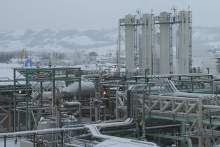
Spectra Energy’s Dawson Creek natural gas liquids (NGLs) processing plant is located in Bessborough, British Columbia, Canada. The processing plant is being developed in two phases. The first phase was inaugurated in July 2012 with the second phase expected to come online in 2013.
Phase one of the Dawson Creek plant has the capacity to process 100m ft³ of raw natural gas per day. The second phase will double the capacity of the plant to 200m ft³ per day.
The Dawson Creek plant enables Spectra to access the gas resources available in the Montney shale gas formation, located in the South Peace region of British Columbia.
Construction and design of the Dawson Creek plant
Spectra Energy announced its decision to build the Dawson Creek plant in June 2010. The plant is part of Spectra’s growth strategy under which it planned to invest $1.5bn in British Columbia over a period of five years.
The plant is spread across an area of 19.2 hectares. Phase two of the project is also being developed within this footprint. The plant includes a double train NGL extraction plant featuring compressor facilities, a vapour recovery unit and a communications tower.
Phase one of the plant is built on a foundation made of 2,100 piles with diameters ranging between 8in and 24in. The piles were driven to about 13m underground to form the foundation structure.
The first phase also required 203,000m³ of sub-soil and top-soil to be removed, 84,000m³ of gravel and about 1,000m³ of concrete to be poured at the site. About 24km of piping, 301km of cable, 1,400t of steel and 200,000in of welding was also required for phase one.
The project required 55km of heat trace to be installed between the insulation and pipes. This provides heat and enables smooth flow of liquid during cold periods. The total number of man hours for phase one was 1.2 million, employing up to 300 workers at any given time.
Natural gas liquids processing at Dawson Creek plant
Raw natural gas or ‘rich gas’ contains valuable hydrocarbons called NGLs which include ethane, propane, butane and pentane (condensate). These NGLs can be separated from the raw gas for use as raw materials in a range of industries. The separated dry gas can be supplied to homes and businesses for cooking and heating purposes.
Raw natural gas is supplied to the plant through Spectra’s Bissette pipeline. The plant produces three primary product,s including two types of NGLs: C5+ (condensate) and C3+ hydrocarbons (propane and butane) and dry sales gas.
C3+ hydrocarbons are extracted by reducing the pressure and temperature of the raw gas. The NGLs contained in the chilled gas steam condense according to their weight at various dew points. The condensed NGLs can be separated and stored in containers for transport.
C5+ hydrocarbons are separated through a process called stabilisation. This process involves the separation of remaining methane, ethane, propane and butane found in liquid form in the raw natural gas. These chemicals are evaporated enabling the remaining C5+ hydrocarbons to be separated, stored and transported.
The extracted NGLs are blended with plant inlet gas and transported through the South Peace Pipeline for further processing at Spectra’s McMahon gas plant located in Taylor, British Columbia.
The processed dry sales gas is distributed to customers through a 1.5km long, 30in diameter short sales gas pipeline. The pipeline connects to the NOVA Gas Transmission Groundbirch pipeline through the Bessborough pipeline.
Contractors involved with Spectra Energy’s gas processing plant
Related project
Mackenzie Gas Project, Canada
The Mackenzie gas project includes the construction of a 1,196km pipeline along the Mackenzie Valley.
KBR has been contracted to carry out general works for phase two of the project. The company was also involved in phase one of the project and was responsible for fabrication and module assembly works.
Aventure Energy was subcontracted to supply pipes for the project.
Focus provided geomatic services for the pipeline, connecting the processing plant to Spectra’s McMahon gas plant.




